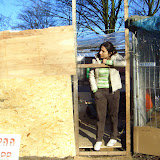I think it demonstrated us that architecture not always can be designed.
 |
| Slum Constructi |
Deconstruction:
It is something to make a reflection about if we realized that the real slum dwellers built and turn down these settlements many times before establish them.
 |
| Slum Deconstruc |





